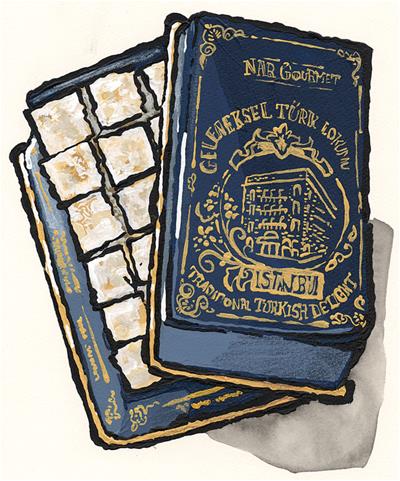Pop quiz: What did Napoleon, Picasso, and Winston Churchill all have in common?
The answer is that they all totally loved Turkish delight. (That’s what you guessed, right?)
They weren’t the only ones. This candy from Turkey captured the imaginations of generations of Europeans, showing up in the writing of Charles Dickens and CS Lewis.
What is Turkish delight anyway?
Think of Turkish delight as the forerunner to a jelly bean. It’s a candy originally from Turkey with a soft, gummy texture. These days it comes in dozens of flavors. It’s usually cut into bite-size cubes. Unlike a jelly bean with its hard exterior, the outside of Turkish delight is just as soft and sticky as the inside, so the cubes are typically coated in powdered sugar so they don’t stick to each other in the box.
You find Turkish delight all over Turkey. If you go to a cafe, there’s a good chance that your little cup of Turkish coffee will come with a piece of Turkish delight skewered on a toothpick. In Istanbul there are tons of colorful shops that sell dozens of varieties of Turkish delight. You might think of them as the Turkish equivalent of a fancy chocolate shop selling lots of different truffles.
To make Turkish delight, you combine sugar and water with a starch and mix it over low heat for a long, long time. These days most is made with corn starch. Back in the 1700s when it was first created, it was made with wheat starch. That starch gives it the jiggly texture.
Candies similar to Turkish delight have been made at home in Turkey for most of the last millennium. The forerunners were made by mixing the starch with sweeteners like grape molasses or honey, so they would have tasted like grape molasses or honey. By making Turkish delight with sugar, the confectioners could add their own flavorings. The earliest recorded recipes for Turkish delight call for adding musk—or, if that was too expensive, you could substitute rose water.
Where does the name “Turkish delight” come from?
In the early 1800s, Istanbul was a popular destination for European travelers who wanted to experience the “exotic Orient.” When they arrived in town, they discovered candy shops selling a treat called “rahat lokum”—the Turkish name for Turkish delight. With its expensive ingredients like sugar and celebrity endorsements from such notable figures as the sultan of Istanbul (who hired a Chief Confectioner to the Palace just to make sure he never ran out of it), eating Turkish delight was the height of fashion for both locals and tourists. Soon the Europeans were exporting the candy back home. Its popularity spread. Story has it that it was Napoleon’s favorite sweet.
By the mid 19th century, shops started popping up in London selling nothing but Turkish delight. Assuming that the English public couldn’t pronounce “rahat lokum,” some marketing genius decided to call the candy “lumps of delight.” In his unfinished novel The Mystery of Edwin Drood, Charles Dickens included a short scene about a visit to a “Lumps-of-Delight shop.” Perhaps because European confectioners couldn’t figure out how to make it themselves—in the 19th century in England starch was used only for stiffening laundry and powdering wigs, not as an ingredient in cooking—the candy continued to be imported from Turkey rather than knocked off locally. Eventually the candy was known by the name Turkish delight.
In Turkey, pistachio is the best selling flavor of Turkish delight.
Maybe in part that’s because the Turkish word for pistachio, fıstık (pronounced fuh-stuk), is slang for a very attractive woman. Just think of the Valentine’s day cards: some pistachios for my pistachio! The pistachios in our Turkish delight come from the town of Gaziantep in southern Turkey. Just like the Piedmont region in northern Italy is famous for hazelnuts and the Périgord region of southwestern France is famous for walnuts, Gaziantep is famous for pistachios. Orchards of pistachio trees blanket the countryside surrounding the city. The pistachios are naturally so green that the baklava in Gaziantep—considered by many in Turkey to be the best in the world—looks like it’s filled with spinach. The pistachios also have incredible flavor, with a deep sweetness.
Our Turkish delight has only five ingredients: sugar, water, cornstarch, roasted pistachios, and citric acid. When you pop one of the knobbly morsels in your mouth, first you notice the delicate, chewy texture and with a bit of crunch from the roasted nuts. Unlike many gummy-like candies that are too dry, or too sticky, the texture is light, almost bouncy, but with a satisfying chew. And the flavor isn’t artificial or overly sweet. It’s subtle, just sweet enough without being cloying, with a deep, rich nuttiness at the base. That flavor lasts a long, long time.
Turkish delight is great paired with a cup of coffee for a mid-morning pick me up or an after dinner treat. It’s also excellent alongside tea or a glass of dessert wine. The local legend in Istanbul is that it was invented to help the sultan woo his wife, and it does make a beautiful gift. But you don’t need an occasion to eat it; Picasso supposedly ate it every day to improve his concentration.

